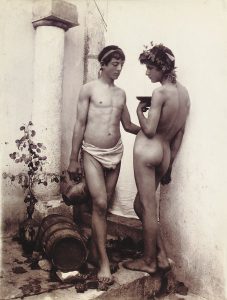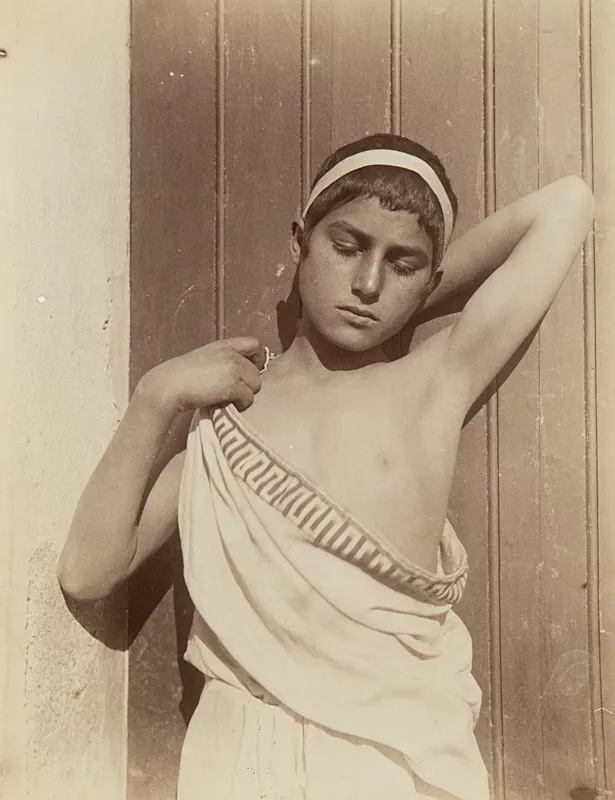Wilhelm von Gloeden’s images of the male nude represent some of the earliest examples of this genre in photography. They are characterized by their sensitivity, grace, and beauty, and are widely regarded as masterpieces of the medium. However, the homoerotic nature of his work also made it controversial and subject to censorship in some quarters. Nevertheless, his influence on later photographers, both in terms of style and technical innovations, cannot be overstated.
The Male Nude In Art And Society
In Western art, the male nude was a staple of religious, mythological, and allegorical painting and sculpture for centuries. With the advent of photography in the 19th century, the male nude took on a new significance, as photographers sought to explore the medium’s potential for capturing the human form.

During the late 19th century, a new wave of homoerotic art emerged in Europe, as artists began to explore and celebrate male sexuality and desire. This movement was influenced by a variety of factors, including the social and political changes of the era, as well as the increasing visibility of homosexuality in popular culture. Gloeden’s photographs of male nudes can be seen as part of this larger trend, as he sought to capture the beauty and sensuality of the male form in his images.
The depiction of the male nude in art and photography has always been a politically and socially charged subject, reflecting the changing attitudes and values of the time. In the late 19th century, the male nude was often seen as a symbol of classical beauty and strength, but it was also associated with homosexuality, a social and cultural taboo in many quarters. Through his photographs, Wilhelm von Gloeden sought to challenge these societal norms and celebrate the beauty of the male form, making a significant contribution to the history of homoerotic art in the process.
Gloeden’s Photographic Approach
Wilhelm von Gloeden arrived in Taormina, Sicily, in 1879, where he lived and worked for the remainder of his life. The island’s natural beauty, combined with its vibrant cultural heritage, provided a rich source of inspiration for his photography.
During his time in Sicily, Wilhelm von Gloeden developed a signature style that combined technical mastery with a deep appreciation for the beauty of the male form. He used his camera to capture the natural grace and sensuality of his subjects, often positioning them in lush, idyllic landscapes or in front of classical ruins. Through his use of light and composition, he sought to create a sense of timelessness and beauty in his images.
Gloeden’s photographs of male nudes are notable for their homoerotic sensibility. He sought to capture the beauty and desirability of the male form, often photographing his subjects in suggestive poses or with overt sexual undertones. Despite the controversial nature of these images, Gloeden’s work was widely celebrated for its technical proficiency and aesthetic vision, as well as its bold, innovative use of nudity and homoeroticism.
Gloeden’s photographs often explore themes of beauty, sensuality, and desire, as well as the relationships between men and nature. He also used his images to comment on the cultural and political events of his time, exploring issues of gender, sexuality, and identity.

Gloeden’s work was part of a larger trend in late 19th-century photography, as photographers sought to explore the medium’s potential for capturing the human form. However, his use of nudity and homoeroticism set him apart from many of his contemporaries, who often focused on more conventional subjects such as landscapes, portraits, and still life. By combining technical mastery with a homoerotic sensibility, Gloeden made a significant contribution to the history of photography, influencing later photographers and artists in the process.
Gloeden’s Technical Innovations
Gloeden was a master of his craft, using his technical proficiency to create images of exceptional beauty and sensitivity. He experimented with various photographic techniques and innovations, such as the use of soft-focus lenses and special filters, to create a unique and timeless quality in his images. He was also known for his use of hand-tinting, which added to the romantic and nostalgic feel of his photographs.
Gloeden’s technical innovations had a lasting impact on the history of photography, inspiring later photographers to push the boundaries of the medium in new and exciting ways. His use of soft-focus lenses, special filters, and hand-tinting techniques paved the way for new styles and techniques, while his focus on capturing the beauty and sensuality of the male form set the stage for future generations of homoerotic photographers.

Gloeden was known for his meticulous and creative approach to photography, spending hours carefully composing each image to achieve the desired effect. He had a deep appreciation for the beauty of the male form, and he used his camera to capture its grace and sensuality in his images. Through his creative process, he sought to create a sense of timeless beauty, drawing inspiration from the natural world and classical art to create images of lasting impact.
Gloeden’s Legacy And Controversies
Wilhelm von Gloeden’s photographs were well-received in his own time, and he was widely regarded as one of the leading photographers of his generation. Despite the homoerotic themes in his work, his images were widely celebrated for their technical proficiency and aesthetic vision. They were popular with both critics and the general public, and were widely exhibited and published throughout Europe and the United States.
Despite his popularity, Wilhelm von Gloeden’s work was not without controversy. The homoerotic themes in his photographs made them a target for censorship and legal challenges, particularly in the more conservative societies of the time. In some countries, his images were banned or destroyed, and he faced numerous legal challenges throughout his career. Despite these challenges, Gloeden continued to create and exhibit his work, and his images have remained a significant part of the history of photography.
Gloeden’s work has been re-evaluated and reappraised, and his photographs are now widely recognized as a significant contribution to the history of photography. While some continue to view his work as controversial and inappropriate, others see it as a bold and innovative expression of sexuality and desire.
Wilhelm von Gloeden’s photographs are significant for the history of photography and homoerotic art in several ways. Firstly, they demonstrate the technical mastery and creative vision of one of the greatest photographers of his generation. Secondly, they showcase the evolution of photography as an art form, as photographers like Gloeden sought to explore new styles and techniques. Finally, they serve as a testament to the power of homoerotic art and its ability to challenge cultural norms and conventions. Through his work, Wilhelm von Gloeden made a lasting contribution to the history of photography and to the broader cultural landscape.




























